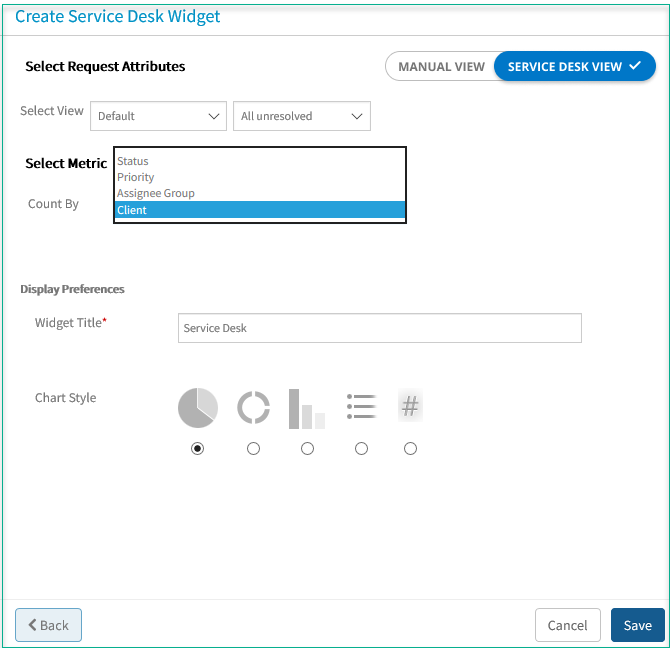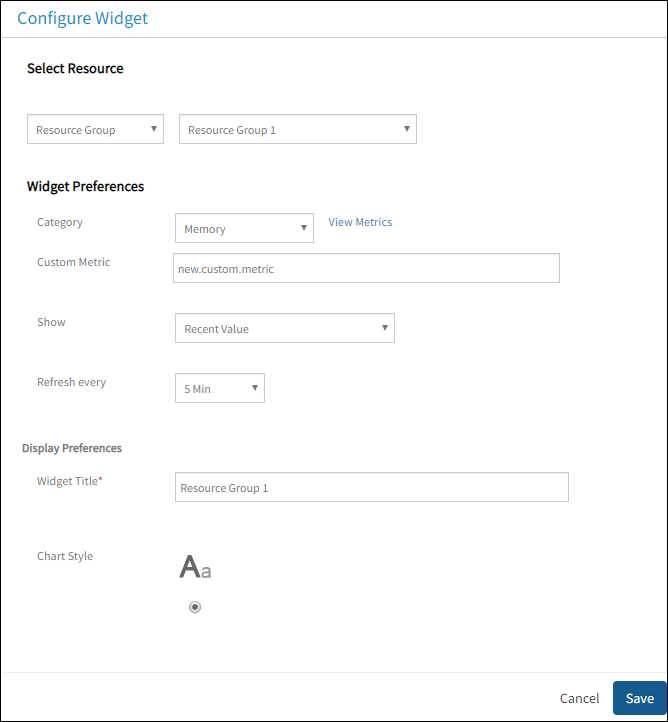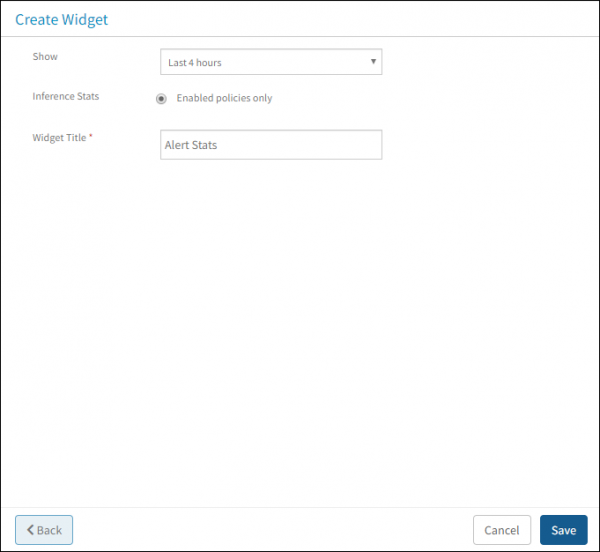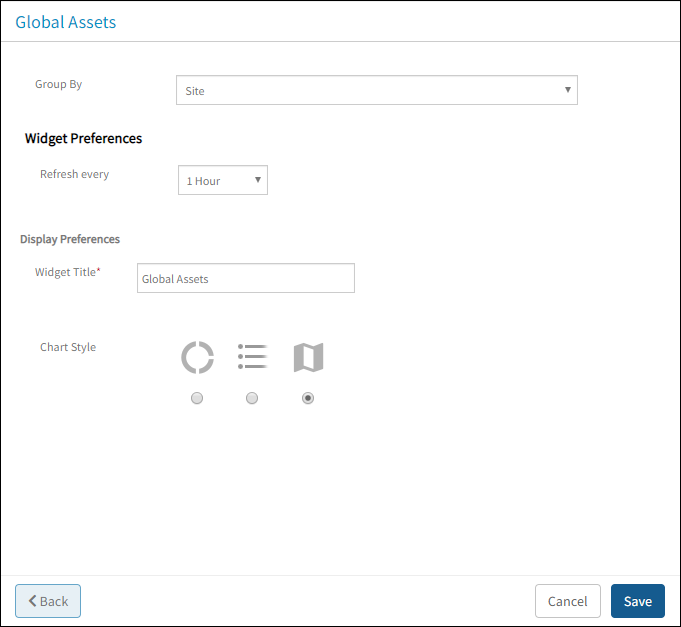Introduction
More than a dozen widgets are available to monitor the status of the resources in your managed environment. Widgets are graphical elements visible in the dashboard layout that can display information as a list, pie chart, donut chart, column chart, or the count.
Creating Service Desk widget
The Service Desk widget helps to track issues according to the settings in Manual View and Service Desk View to facilitate easy tracking of issues based on metrics, such as Clients, Group, Priority, and Status. The widget helps to view request types, such as Service Requests, Tasks, Incidents, Problems, Change Requests, and Time-bound requests.
To create the widget:
- Select Dashboard.
- Select a client from the All Clients list.
- Click + Add Widget and go to the MOST USED WIDGET section.
- Select Service Desk > Create Widget.
- Clicke of the following options:
- Manual View
- Service Desk View
- For Service Desk View, enter the following information and click Save:
- Select Request Attribues: Select one of the options from Select View and then select status of issue from the drop-down menu.
- Select Metric: Select one of the following metrics for Count By:
- Clients
- Assignee Group
- Priority
- Status
- Display Preferences: Enter a name for Widget Title and select desired Chart Style.
- For Manual View, enter the following information and click Save:
- Select Request Attribues: Select one of the options from Request Type, select a Source, and then select Source Policy Type from the drop-down menu.
- Select Metric: Select desired options for Metric, Count By, and Duration.
- Display Preferences: Enter a name for Widget Title and select desired Chart Style.

Service Desk Widget
Creating alert stats widget
The alert stats widget displays the total number of events, correlated alerts, inference alerts, auto-ticketed, and auto-suppressed alerts over a specific period of time.
To create Alerts Stats widget:
- Select Dashboard.
- Select a client from the All Clients list.
- Click + Add Widget and go to the MOST USED WIDGET section.
- Select Alert Stats > Create Widget, provide the following information and Save:
- Show: Refers to the data displayed in the selected time frame.
Example: Last 8 Hours. - Inference Stats: Refers to the type of alert data in the widget displayed according to Enabled policies only.
- Widget Title: Refers to the name of the widget.
- Show: Refers to the data displayed in the selected time frame.

Alert Stats Widget
Creating top metric utilization widget
The top metric utilization widget displays the latest or last six hours aggregate values of the top resources fpr CPU, Disk, Memory, Interfaces, WANLink Utilization.
To create a Top Metric Utilization widget:
- Select Dashboard.
- Select a client from the All Clients list.
- Select + Add Widget > OTHER PREDEFINED WIDGET section.
- Select Top Metric Utilization, provide the following information, and Save:
- Select Resource to select one of the following:
- All Resources
- Resource Group
- Service Group
- Site
- Kubernetes
- Docker
- Widget Preferences to provide the following information:
- Category: Refers to the type of metric that you want to display in the Dashboard. Click View Metrics for metrics information associated with the selected category.
- Custom Metric: Refers to the metric that you can provide apart from the values displayed in View Metrics.
- Show: Refers to the data displayed in the selected time frame.
Example: Recent Value. - Refresh every: Refers to the time available to update the data displayed in the Dashboard.
- Display Preferences to provide the following information:
- Widget Title: Refers to the name that you want to display as the widget title in the dashboard.
- Chart Style: Refers to the HTML format to display data.
- Select Resource to select one of the following:

Top Metric Utilization Widget
Creating alert trend widget
The alert trend widget displays the total non-acknowledged critical and warning alerts over a specific time duration.
To create an alert trend widget:
- Select Dashboard.
- Select a client from the All Clients list.
- Click + Add Widget and go to the OTHER PREDEFINED WIDGET section.
- Select Alert Trend, provide the following information, and Save:
- Select Resources to select the desired resource.
- Widget Preferences to provide the following information:
- Time Range: Refers to the data displayed in the selected time frame. For example, Last 1 day.
- Refresh every: Refers to the time available to update the data displayed in the Dashboard.
- Display Preferences to provide the following information:
- Widget Title: Refers to the name that you want to display as the widget title in the dashboard.
- Chart Style: Refers to one of the following formats to display data.
- LINE CHART
- AREA CHART

Alert Stats Widget
Creating patch compliance widget
The patch compliance widget displays the compliance status for a set of devices at a specific baseline. The widget provides the compliance status of a group of devices using the latest compliance data available.
The Patch Compliance widget provides the following types of data:
- Number of non-compliant devices
- Number of compliant devices
For example, in a resource group Application Server of 25 devices and a baseline with a group of patches, the compliance is calculated for the baseline against the 25 devices and the compliance data is populated accordingly.
To create a Patch Compliance widget:
- Select Dashboard.
- Select a client from the All Clients list.
- Select + Add Widget > OTHER PREDEFINED WIDGET section.
- Select Patch Compliance, provide the following information, and Save.
- Resource Group: Refers to the name of the selected resource group.
- Baseline: Refers to the selected baseline.
- Widget Preferences, select time available to update the data displayed in the Dashboard.
- Display Preferences to provide the following information:
- Widget Title: Refers to the name that you want to display as the widget title in the dashboard.
- Chart Style: Refers to one of the following formats to display data.
- DONUT CHART
- PIE CHART
- COLUMN CHART
Note
To show the number compliant and non-compliant resources, select a baseline. For example:
- Resource Group: Application Server
- Baseline: Windows_2008_R2

Patch Compliance Widget
Creating a global assets widget
Global assets widget shows the geographical distribution of your IT assets that includes assets in your data center and in the cloud.
Important
To locate your data center on the geographical map, adding a site is mandatory.
- Go to Infrastructure > Site to add a site location.
- (Required) City, State, and Country fields are mandatory when adding a site location
with the
Global Assetswidget.
To create a Global Assets widget:
- Select Dashboard.
- Select a client from the All Clients list.
- Select + Add Widget > OTHER PREDEFINED WIDGET section.
- Go to Global Assets, provide the following information, and Save:
- Group By drop-down, select one of the following options:
- Region
- Cloud Account
- Tags
- Provider Type
- Site
- Resource Type
- Device Type
- Widget Preferences to configure the Refresh time.
- Display Preferences to provide the following information:
- Widget Title: Refers to the name that you want to display as the widget title in the dashboard.
- Chart Style: Refers to one of the following charts:
- DONUT CHART
- LINE CHART
- GEO CHART
- Group By drop-down, select one of the following options:

Global Assets Widget
Viewing cloud cost widgets
Cloud Cost Insights widget
The cloud cost insights widget shows Months-to-Date spends of the public cloud by default. Choose a different timeline to show total spending for a specific time period. View a breakdown of spending by cloud account or by custom attributes. Example: Business units and other attributes.
Cloud Cost Trend widget
The cloud cost trend widget shows a trend of spending on public clouds over a period of time. You can view the trend by resource type, custom attributes, and other attributes.
What to do next
- See Cloud Cost Trend.
- See Cloud Cost Insights.